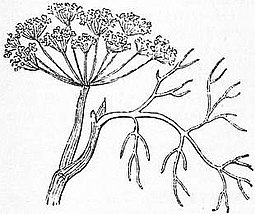 |
Dill (Anethum or Peucedanum graveolens), leaf and inflorescence. |
DILL (Anethum or Peucedanum graveolens), a member of the natural botanical order Umbelliferae, indigenous to the south of Europe, Egypt and the Cape of Good Hope. It resembles fennel in appearance. Its root is long and fusiform; the stem is round, jointed and about a yard high; the leaves have fragrant leaflets; and the fruits are brown, oval and concavo-convex. The plant flowers from June till August in England. The seeds are sown, preferably as soon as ripe, either broadcast or in drills between 6 and 12 in. asunder. The young plants should be thinned when 3 or 4 weeks old, so as to be at distances of about 10 in. A sheltered spot and dry soil are needed for the production of the seed in the climate of England. The leaves of the dill are used in soups and sauces, and, as well as the umbels, for flavouring pickles. The seeds are employed for the preparation of dill-water and oil of dill; they are largely consumed in the manufacture of gin, and, when ground, are eaten in the East as a condiment. The British Pharmacopoeia contains the Aqua Anethi or dill-water (dose 1-2 oz.), and the Oleum Anethi, almost identical in composition with caraway oil, and given in doses of 12-3 minims. Dill-water is largely used as a carminative for children, and as a vehicle for the exhibition of nauseous drugs.